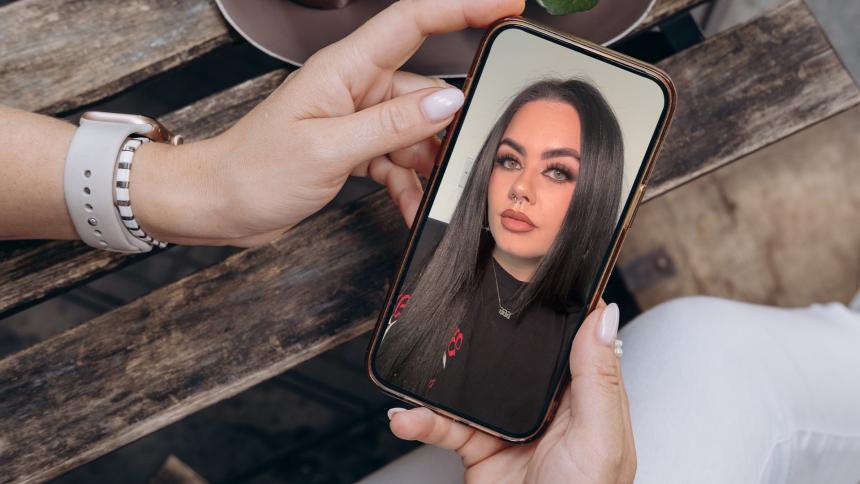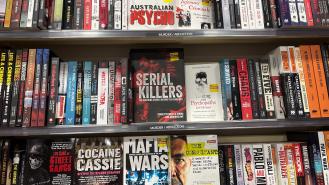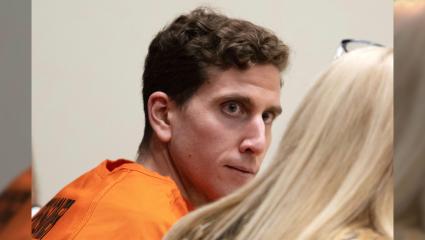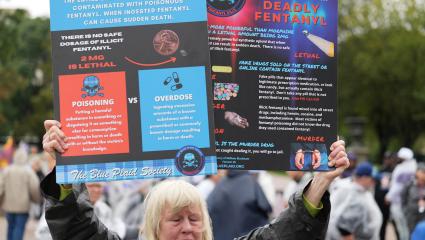
How true crime became so popular according to one of Britain's biggest creators
For decades, true crime has fascinated audiences, offering both a mirror to society’s darkest corners and a way of making sense of them. But while the interest itself is not new, the format of storytelling has transformed beyond recognition. Once rooted in TV dramas and evening documentaries, true crime has shifted into streaming binges, podcast feeds and even 60-second TikTok clips.
What has changed most is not the fascination itself, but the way people choose to engage with it. Each new platform has reshaped how stories are told and how audiences participate, turning passive viewers into active commentators and communities of fans.
Few embody this transformation better than True Crime Caitlyn, a creator with more than half a million followers.
Caitlyn sat down with Crime+Investigation to discuss her journey – from watching CSI with her grandmother to creating viral TikTok videos – and revealed how platforms, formats and audiences have reshaped the way true crime is told.
The rise of forensic fiction
For many, the earliest exposure to true crime came through television. Scripted series popularised forensic science and gave audiences a stylised glimpse into the criminal justice system. Alongside them, documentary specials and news coverage made real-life cases part of everyday conversation.
Caitlyn recalls her own introduction vividly: 'For a lot of us, the world of true crime was opened by our parents. Many people’s fascination began with detective or crime shows they watched growing up. For me, it was my Nana, who raised me. She always had NCIS or CSI: Miami on the TV, and I would sit and watch it with her.'
For a generation who grew up with these shows playing in the background, crime stories became both familiar and formative. They seeded a curiosity that would later find expression in new media and grow enormously in popularity, with a 400% increase in people searching Google for 'true crime' over the past decade.
That curiosity soon spilled over into real life, fuelling a surge of interest in forensic science as a career. Google Trends data shows how dramatically the appetite grew, with a 700% increase in global interest over two decades, peaking in May 2025. What began as entertainment on TV screens was increasingly shaping university applications, career choices and the professional landscape of criminology.
Caitlyn believes this boom is only just beginning and that it could have real-world consequences: 'I think the boom will continue, and I hope it will impact the world in a positive way. People who develop an interest in true crime may want to pursue careers in the police, forensics or law. And this can only be a good thing.'
@truecrimecaitlyn The Watts Family Case #fyp #truecrime #truecrimetok #truecrimecases #crimetok #solvedcase #chriswatts #shanannwatts #wattsfamily ♬ original sound - truecrimecaitlyn
Crime on the front page
Alongside fictional dramas and documentary specials, real-world cases dominated the news cycle and brought true crime into everyday conversation. These cases weren’t just news events. They were cultural moments, discussed in living rooms, classrooms and workplaces around the world.
For Caitlyn, those moments were formative. 'I remember my Nana watching the news each morning and following the disappearance of Madeleine McCann. At the time we would go on family holidays, and it struck me that it could’ve been me. It could’ve been anyone. Her case stuck with me.'
Later, she discovered the James Bulger case at age 11, similar age as the perpetrators. 'I became so interested in how someone my age could commit such evil. Why did they do it? What drove them to it? I still carry those questions with me today. I think my generation, being inquisitive as we are, always want to know: Why? How?'
This wave of high-profile cases gave true crime a new kind of visibility. It blurred the line between private tragedy and public spectacle, and for many it marked the first time crime was seen not as scripted entertainment, but as a reality unfolding in real time. These moments primed audiences for the more immersive, investigative storytelling that would later flourish on streaming platforms.
The streaming revolution
If TV planted the seed, streaming made true crime bloom.
Netflix’s Making a Murderer (2015) marked a turning point. Its episodic structure, bingeable format and cliffhanger storytelling drew millions into long-form true crime like never before.
Other series soon followed, from The Keepers to Don’t F**k with Cats, each sparking global debates. Viewers were no longer just passive consumers. They were armchair detectives, discussing theories online and demanding answers from institutions.
Streaming also blurred the lines between entertainment and investigation. The depth and reach of these shows expanded expectations – audiences wanted more detail, more context and more access.
Ask any true crime fan where their fascination began, and you’ll usually get a vivid answer. We spoke to five members of a true crime community to learn where it all began for them.
For Robyn (33), it was television documentaries that left a lasting mark: 'The first one I remember or that stuck with me was There’s Something Wrong With Aunt Diane.' Similarly, Aydan (27) recalls sensational news cases as making an early impact: 'I started with cases like Casey Anthony on Crime Watch Daily and the OJ Simpson drama.'
Streaming also blurred the lines between entertainment and investigation. The depth and reach of these shows expanded expectations – audiences wanted more detail, more context and more access.
The podcast boom
While Netflix redefined true crime for the screen, podcasts transformed it for the ear. The launch of Serial in 2014 showed how audio could sustain complex narratives, weaving in testimony, analysis and speculation. Since then, true crime has become one of podcasting’s most dominant genres.
41% of podcast listeners now regularly consume true crime content, according to Pew Research (2023). For many fans, podcasts weren’t just another format, they were the starting point. Ben (31) told us: 'The first thing I really got into was Serial. It was very heavy investigative journalism, which I don’t listen to anymore. Now I watch more video content.'
These memories underline how each generation has its own entry point into true crime. Whether it was a shocking documentary, a high-profile trial or a podcast phenomenon, the path into the genre often reflects the media of its time and sets the stage for how fans consume stories later on.
The podcast format thrives on its intimacy: a host’s voice in your headphones, telling you the story as if across a table. It also fits seamlessly into daily routines – the commute, the gym, household chores.
For younger audiences in particular, podcasts became a way to dig deeper, moving beyond the glossy veneer of TV into more textured storytelling.
TikTok and the short form shift
In the last few years, TikTok has transformed the landscape again. Where Netflix and podcasts offer length and depth, TikTok thrives on brevity and accessibility.
As Caitlyn explains, it’s been a game-changer: 'TikTok has completely changed the true crime world in all aspects. The For You Page makes it easier than ever to find new content.'
Robyn agrees that it makes cases far easier to discover: 'It introduces cases I haven’t heard of or ones happening right now, so you can follow them as they unfold. For example, the Idaho murders or Emily Long who just killed her whole family except for her youngest because her husband got diagnosed with brain cancer.'
Others agreed it happens constantly: 'Some of the most interesting cases I’ve discovered were completely unexpected, just popping up on my social media feed,' Kim (38) says.
This shift highlights how algorithms aren’t just shaping how true crime is watched, but also what cases enter the spotlight.
With videos capped at 10 minutes on TikTok, the platform suits multitasking viewers.
Caitlyn also sees how this style of delivery suits busy, multitasking viewers: 'For some people, 10 minutes and under is the perfect amount of time to tune in while you’re getting ready or cooking.'
This snackable format means audiences can dip in and out of crime stories without committing to hours of content. It also allows creators to respond quickly to new developments, making true crime feel immediate and interactive.
However, TikTok’s openness comes with risks. While it has empowered ethical creators like Caitlyn, it has also enabled sensationalism and misinformation to spread rapidly. The challenge is balancing accessibility with responsibility.
For Robyn, the lack of traditional production techniques is a plus: 'They do less reenactment, which I prefer.' In contrast, Seb (38) believes that the looser format can make content feel 'more exaggerated, probably because it’s less regulated.'
Several fans highlighted how personality-driven storytelling sets creators apart: 'On YouTube and TikTok it’s usually a personality telling the story, rather than the traditional talking heads format. On TikTok, it feels like you’re getting all the best bits without the repetition you find in longer documentaries.' Aydan says.
Not everyone is convinced, though. As Kim puts it, 'Personally, TikTok and YouTube true crime content isn’t really for me. I think we all end up feeling like our own experts after consuming so much crime content anyway.'
Generational divide: old formats vs new platforms
The evolution of formats has created a clear generational divide in how true crime is consumed. Older audiences remain loyal to television documentaries and long-form investigations, while younger fans increasingly turn to TikTok, YouTube and podcasts.
Caitlyn sees this divide reflected clearly in her own audience. More than a third of her followers (35.9%) are aged 18–24, with another 36.1% in the 25–34 bracket. Even among older groups, the interest is there. Around 3% of her community is aged 55 and above.
As Caitlyn explains, 'My audience has always been prominently younger, which I think comes down to TikTok having so many younger users. I know my cousins and grandparents don’t even have the TikTok app but they’ll happily sit and watch a documentary on Crime+Investigation.'
And when it comes to format, fans are divided. For Kim, 'Long-form TV series are my go-to for true crime. I can binge without annoying ad breaks.'
Others enjoy a mix: 'I like both, but under 20 minutes is my happy medium,' Robyn says. For many, time is the deciding factor: 'I’m usually short on time, so shorter is better,' Seb argues.
Aydan says that accessibility often determines what he watches: 'I enjoy long-form content more, but because short-form is so accessible, I often end up watching that. If something goes viral, then I’ll want to see the full documentary.'
And for some like Ben, the sweet spot lies in balance: 'It depends on the case. I like three-part series, but not ten-part ones.'
This coexistence highlights a wider truth: while platforms change, the fascination with crime stories endures across generations. The difference lies in delivery and engagement.
Creators shaping the genre
Caitlyn’s rise is part of a broader shift in true crime. Where once television networks and documentary makers set the tone, today individual creators can be as influential.
Caitlyn’s focus: factual, respectful storytelling that avoids sensationalism and honours victims. Within three years, she had built a community of more than half a million followers, most of them under 35.
With her mix of research, personality and accessible delivery, Caitlyn shows how digital platforms are not only reshaping the way stories reach audiences, but also redefining the storytellers themselves.
Her journey illustrates not only how platforms shape creators, but how creators themselves shape the genre – blending traditional research with modern, accessible delivery.
Take a look at one of Caitlyn’s latest videos about America’s most dangerous prisoners and see for yourself:
@truecrimecaitlyn The Case of Jamie Osuna | #fyp #truecrime #crimetok #solved ♬ original sound - truecrimecaitlyn
Looking ahead, true crime is unlikely to abandon any format entirely. Television documentaries, streaming series, podcasts and TikTok videos will coexist, each serving different audiences and purposes.
But younger generations are setting the direction. They value speed, interactivity and shareability, which means short-form content will continue to grow. At the same time, their demand for respect and accuracy may push creators and platforms towards higher ethical standards.
Why the storytelling evolution matters
The journey of true crime storytelling – from the scripted world of CSI to the immediacy of TikTok – reflects more than just changes in media technology. It tells us about audiences themselves: their habits, their anxieties, their need for both education and connection.
Kim told us that sharing has become part of the experience. 'We share new true crime docs on WhatsApp with a quick "have you seen this?" and then chat once we’ve both watched.' Aydan adds: 'There are more people to talk to about it now because true crime has become more mainstream.' Seb summed it up simply: 'I always start with "Have you watched…?" — I wouldn’t have said that 10 years ago.'
True crime is no longer just consumed; it’s discussed, debated and dissected in everyday conversation.
Creators like Caitlyn embody this shift. Rooted in traditional storytelling but thriving in new digital spaces, they show how true crime continues to evolve with each generation.
The fascination with crime has always been there. What has changed – and will continue to change – is how those stories are told, shared and understood.
Can’t get enough of all things true crime? Stay in the know with the Crime+Investigation newsletter! Get exclusive access to new articles, episodes, clips, competitions and more – delivered weekly and completely free. Don't miss out – sign up today!













